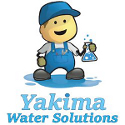Hard Water and Softening
Every household and every business or factory uses water, and none of it is pure. One class of impurity that is of special interest is “hardness”. This refers to the presence of dissolved ions, mainly of calcium Ca2+ and magnesium Mg2+ which are acquired through contact with rocks and sediments in the environment. The positive electrical charges of these ions are balanced by the presence of anions (negative ions), of which bicarbonate HCO3– and carbonate CO32– are most important. These ions have their origins in limestone sediments and also from carbon dioxide which is present in all waters exposed to the atmosphere and especially in groundwaters.
Origin of water hardness
Carbon dioxide reacts with water to form carbonic acid (1) which at ordinary environmental pH exists mostly as bicarbonate ion (2). Microscopic marine organisms take this up as carbonate (4) to form calcite skeletons which, over millions of years, have built up extensive limestone deposits. Groundwaters, made slightly acidic by CO2 (both that absorbed from the air and from the respiration of soil bacteria) dissolve the limestone (3), thereby acquiring calcium and bicarbonate ions and becoming “hard”. If the HCO3– concentration is sufficiently great, the combination of processes (2) and (4) causes calcium carbonate (“lime scale”) to precipitate out on surfaces such as the insides of pipes. (Calcium bicarbonate itself does not form a solid, but always precipitates as CaCO3.)
These “hardness ions” cause two major kinds of problems. First, the metal cations react with soaps, causing them to form an unsightly precipitate— the familiar “bathtub ring”. More seriously, the calcium and magnesium carbonates tend to precipitate out as adherent solids on the surfaces of pipes and especially on the hot heat exchanger surfaces of boilers. The resulting scale buildup can impede water flow in pipes. In boilers, the deposits act as thermal insulation that impedes the flow of heat into the water; this not only reduces heating efficiency, but allows the metal to overheat, which in pressurized systems can lead to catastrophic failure.
Most conventional water-softening devices depend on a process known as ion-exchange in which “hardness” ions trade places with sodium and chloride ions that are loosely bound to an ion-exchange resin or a zeolite (many zeolite minerals occur in nature, but specialized ones are often made artificially.)

The illustration depicts a negatively-charged zeolite to which [positive] sodium ions are attached. Calcium or magnesium ions in the water displace sodium ions, which are released into the water. In a similar way, positively-charged zeolites bind negatively-charged chloride ions (Cl–), which get displaced by bicarbonate ions in the water. As the zeolites become converted to their Ca2+ and HCO3– forms they gradually lose their effectiveness and must be regenerated. This is accomplished by passing a concentrated brine solution though them, causing the above reaction to be reversed.
“Alternative” water softening methods
The great economic importance of water softening has created a large and thriving industry that utilizes a number of proven methods based on well established scientific principles. It has also unfortunately attracted a variety of operators offering technologies that are purported to be better, less expensive, easier to install, or “chemical-free”, but which have never been validated scientifically and whose principles of operation are largely unexplained by the known laws of chemistry. This does not mean that such schemes cannot work (after all, we can use theory to show that under idealized conditions, water can never boil and it can never rain!), but it should inspire a good degree of skepticism. Most of the statements supporting alternative water treatment methods come from those who have a commercial interest in these devices, they are not supported by credible and independently verifiable performance data, and the explanations they offer for how they work reveal such a weak understanding of basic chemistry on the part of their authors that it is difficult to have much confidence in them.
Against this, there is some anecdotal evidence that certain magnetic and electromagnetic devices can be effective in preventing scale formation in hard water systems. It is very difficult to judge such claims, which are almost never based on tests that are well enough described to allow others to evaluate them and to verify the results. While the lack of “scientific” evidence does not in itself invalidate a claim for the efficacy of a device, it should make one hesitate to accept it without some guarantee of performance.
Magnetic water softening and “scale” control
There is a long history of the promotion of magnets to alleviate the “hardness” of mineral-containing waters, and particularly to control the deposition of scale in teapots, plumbing systems, evaporators, and boilers. There are now a large variety of devices on the market that claim to reduce scale deposition, and some claim to “soften” the water as well. The earlier devices mostly employed permanent magnets, but many now use alternating magnetic or electrostatic fields. The magnetic field surrounds the pipe at some point and penetrates it from all sides. This obviously limits its use to non-ferrous pipes such as copper or plastic.
Although magnetic water treatment (MWT) products have been promoted since the 1930’s, they have not received very wide acceptance within the engineering community, and the question of whether or not they are effective is still very much open. The widespread marketing of MWT products to consumers via the Internet has done little to settle the issue.
